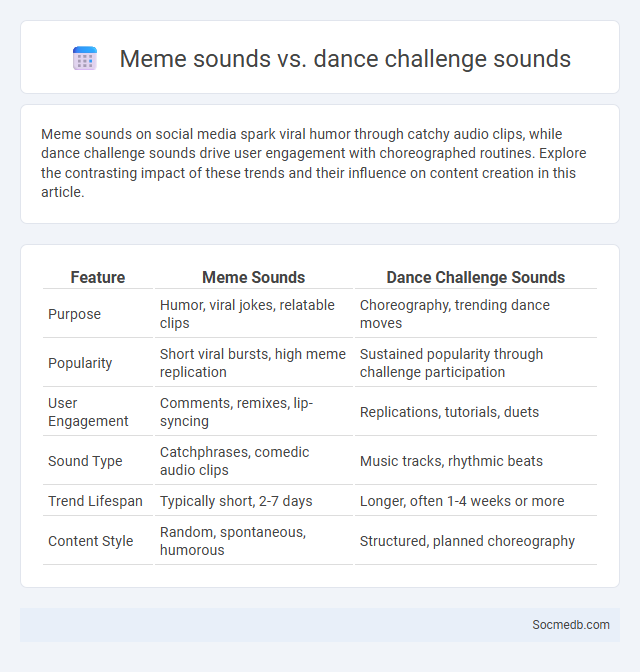
Photo illustration: meme sounds vs dance challenge sounds
Meme sounds on social media spark viral humor through catchy audio clips, while dance challenge sounds drive user engagement with choreographed routines. Explore the contrasting impact of these trends and their influence on content creation in this article.
Table of Comparison
| Feature | Meme Sounds | Dance Challenge Sounds |
|---|---|---|
| Purpose | Humor, viral jokes, relatable clips | Choreography, trending dance moves |
| Popularity | Short viral bursts, high meme replication | Sustained popularity through challenge participation |
| User Engagement | Comments, remixes, lip-syncing | Replications, tutorials, duets |
| Sound Type | Catchphrases, comedic audio clips | Music tracks, rhythmic beats |
| Trend Lifespan | Typically short, 2-7 days | Longer, often 1-4 weeks or more |
| Content Style | Random, spontaneous, humorous | Structured, planned choreography |
Understanding Meme Sounds: Definition and Impact
Meme sounds are short, catchy audio clips that gain viral popularity on social media platforms like TikTok, Instagram, and Twitter, often shaping online trends and user interactions. These sounds can evoke emotions, create community bonds, and influence meme culture by adding a layer of audio context that enhances visual content. Understanding meme sounds helps you leverage their impact for engaging content creation and amplifying your social media presence effectively.
What Sets Dance Challenge Sounds Apart
Dance challenge sounds stand out due to their viral nature, catchy rhythms, and ease of replication, which encourage widespread participation and community engagement. These sounds often feature specific beats or hooks that align perfectly with choreographed moves, making it easier for creators to synchronize and share their performances. Your content gains increased visibility and interaction when leveraging these unique audio elements popular across platforms like TikTok and Instagram.
Exploring the Evolution of Trending Sounds
Trending sounds on social media platforms have evolved from simple viral tunes to complex audio snippets that shape digital culture and user engagement. The integration of AI algorithms continuously adapts these sounds to user preferences, increasing your content's reach and relevance. Understanding this evolution allows you to leverage popular audio trends for enhanced social media impact and follower growth.
Key Differences: Meme vs. Dance Challenge vs. Trending Sounds
Memes are primarily static or animated images paired with humorous or relatable text, designed to quickly convey specific jokes or cultural commentary. Dance challenges engage users through choreographed routines that encourage participation and viral replication, often linked to social media platforms like TikTok or Instagram Reels. Trending sounds involve popular audio clips, including music or viral phrases, that users integrate into various content forms to increase visibility and leverage platform algorithms.
How Meme Sounds Influence Online Culture
Meme sounds have become a powerful tool shaping online culture by enhancing emotional expression and humor within digital communities. Your use of recognizable audio clips can create shared experiences and foster a sense of belonging among social media users, driving viral trends and increasing engagement. These sounds often transcend language barriers, making memes more accessible and amplifying their impact across diverse audiences.
Viral Power: Dance Challenge Sounds on Social Media
Dance challenge sounds on social media harness viral power by sparking user creativity and encouraging widespread participation. These catchy audio clips drive massive engagement, boosting algorithmic visibility and accelerating content sharing. You can leverage trending dance challenge sounds to amplify your reach and connect with diverse online communities.
The Lifecycle of Trending Sounds
Trending sounds on social media platforms like TikTok and Instagram often follow a lifecycle that begins with viral adoption by influential creators, leading to rapid user-generated content creation. As the sound gains popularity, it becomes embedded in various trends, memes, and challenges, maximizing engagement and reach. Over time, the sound's usage wanes as new audio emerges, prompting cycling through new trends and sustaining platform dynamism.
Audience Engagement: Which Sounds Go Viral?
High-pitched, catchy sounds and rhythmic beats frequently drive viral trends on social media platforms like TikTok and Instagram Reels. Sounds with clear, repetitive hooks that evoke emotional responses or humor significantly boost audience engagement and shareability. Data shows viral audio clips often originate from popular songs, user-generated content, or trending challenges that encourage audience interaction and participation.
Creative Trends: Memes, Dance, and the Sound Frontier
Creative trends on social media increasingly revolve around memes, viral dance challenges, and the exploration of sound as a dynamic content tool. Memes evolve rapidly, reflecting cultural moments with humor, while dance trends drive user engagement through replicable choreography on platforms like TikTok. Sound plays a crucial role in content virality, with unique audio clips sparking new trends and influencing how audiences interact with videos.
Future Predictions: The Next Wave of Viral Sounds
The future of social media will be dominated by AI-generated viral sounds that adapt to trending topics in real-time, boosting engagement through hyper-personalized audio content. Interactive features such as AR-enhanced music layers and user-driven remix tools are expected to reshape how viral sounds spread across platforms like TikTok and Instagram. Data analytics predicting viral sound patterns will enable creators to craft hits with higher accuracy, revolutionizing audio content virality in the next wave of social media trends.
 socmedb.com
socmedb.com